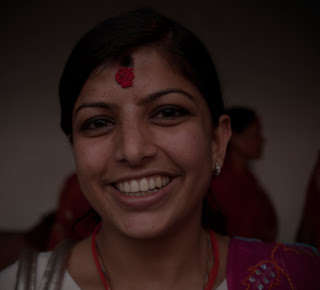 This image, a pair of cute Nepali sisters, shot with Canon 1Ds III with EF 85/1.2L, the aperture set to f/3.2 so it gives the subject a nice sharp record, while a little blur on the vibrant brick wall. Nepali girls really like to be photographed, just ask them. Some may ask for rupees, more common on a tourist attraction, I prefer to give candy to girls and boys, not their preference, but perfectly acceptable. Make sure you got some in your pocket.
This image, a pair of cute Nepali sisters, shot with Canon 1Ds III with EF 85/1.2L, the aperture set to f/3.2 so it gives the subject a nice sharp record, while a little blur on the vibrant brick wall. Nepali girls really like to be photographed, just ask them. Some may ask for rupees, more common on a tourist attraction, I prefer to give candy to girls and boys, not their preference, but perfectly acceptable. Make sure you got some in your pocket. Another image of this cute pair of sisters, still with Canon 1Ds III with 85/1.2L. A little flare on the image, does not bother with it, at least I don't. Falre is sometimes one of the judgements over a lens character and optical quality, but very seldom a factor of a picture quality. In fact some picture intended to have flares. Picture quality is not lens quality, because you don't shoot for lens reveiw, you shoot for something of interest to you. So my suggestion to a lot of photographers, look at the quality of image beyond the way one typically read at text-book-type lens review. Remember, those who can't do, TEACH. Those who can't teach, TEACH GYM. No offence to the real gym teacher, I am not saying you.
Another image of this cute pair of sisters, still with Canon 1Ds III with 85/1.2L. A little flare on the image, does not bother with it, at least I don't. Falre is sometimes one of the judgements over a lens character and optical quality, but very seldom a factor of a picture quality. In fact some picture intended to have flares. Picture quality is not lens quality, because you don't shoot for lens reveiw, you shoot for something of interest to you. So my suggestion to a lot of photographers, look at the quality of image beyond the way one typically read at text-book-type lens review. Remember, those who can't do, TEACH. Those who can't teach, TEACH GYM. No offence to the real gym teacher, I am not saying you. One more image of the younger sister, same camera and same set up, and this time with the Canon 5DII mounted with EF 70-200/2.8L IS as a prop. One may notice I use Arca Swiss ballhead, on a carbon fiber Gitzo tripod - my most often use travel tripod. My Arca Swiss ballhead is almost 20 old years old, still being heavily use, says about the qaulity of the tool. And it is so good, and I got so acustomed using it, I don't care if there is a better quality one (doubtful) or cheaper one (plenty copies in the market), the fact it has served me for so long, it is cheap enough. What one might also found on this image is the use of a RRS L plate and the lens quick plate. Highly recommended! Go to the original source RRS. One more thing, since most of today's DSLR or the EVIL (Electronic Viewfinder Interchangeable Lens) or pocket cameras feature live view: turn it on, you get picture like this a lot easier.
One more image of the younger sister, same camera and same set up, and this time with the Canon 5DII mounted with EF 70-200/2.8L IS as a prop. One may notice I use Arca Swiss ballhead, on a carbon fiber Gitzo tripod - my most often use travel tripod. My Arca Swiss ballhead is almost 20 old years old, still being heavily use, says about the qaulity of the tool. And it is so good, and I got so acustomed using it, I don't care if there is a better quality one (doubtful) or cheaper one (plenty copies in the market), the fact it has served me for so long, it is cheap enough. What one might also found on this image is the use of a RRS L plate and the lens quick plate. Highly recommended! Go to the original source RRS. One more thing, since most of today's DSLR or the EVIL (Electronic Viewfinder Interchangeable Lens) or pocket cameras feature live view: turn it on, you get picture like this a lot easier.I made quite a few more images on these little sister, with different ways of shooting them. My advice is: target your subject, work with them, perhaps with different variety of images, don't just machine gun shooting too many of smae images.



























